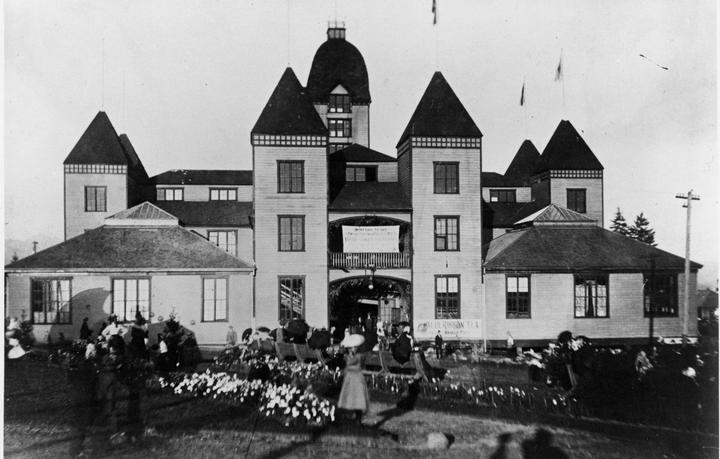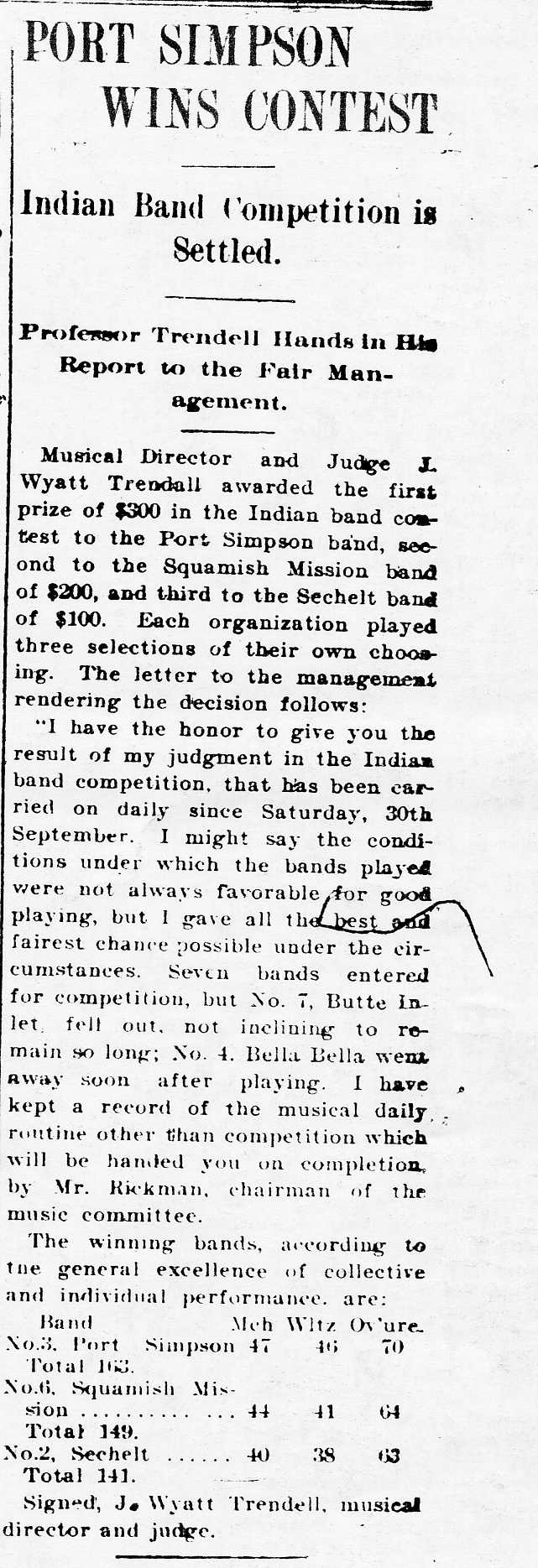VABBS
HomeAbout VABBS
Members
Events
News Archive
What is a Brass Band?
Research Project: History of Brass Bands in BC
Links
Little Mountain Brass BandBrass Belles
Other Links
Contacts
Brian StrideJim Littleford
Web Administrator
Research Project: History of Brass Bands in British Columbia
First Nations Brass Band Contest
1905 Dominion Exhibition, New Westminster, British Columbia
Credits
Much of the information in this article is summarized from the following publications:
All records maintained by the exhibition were destroyed in a fire in 1929.

New Westminster Daily Columbian Newspaper, New Westminster Public Library Database, ca. 1905
Agricultural Hall, Exhibition Buildings, Queen's Park, New Westminster.
Signs read: 1) "Don't fail to see the two greatest novelties in the world:
Edison's Concert Phonograph and Automatic Banjo" and 2) "Blue ribbon tea served free"
- Dominion Exhibition, September 27 - October 7, 1905
- Department of Indian Affairs brought 7 First Nations brass bands to the Exhibition to perform in a brass band contest.
- First Nations bands in attendance:
- Aiyansh
- Bella Bella
- Bute Inlet
- Nass River
- Port Simpson
- Sechelt
- Squamish
- Other bands participated in the Exhibition, including the Irish Guards, Vancouver Piper's Band, Revelstoke Band, and 6th Artillery Regiment Band. These bands did not compete.
- J. Wyatt Trendell, who later became director of the Duke of Connaught's Own Rifles [this regiment carries on in the present day as The British Columbia Regiment (Duke of Connaught's Own)], was the adjudicator for the event.
- The event began with all seven bands forming three sides of a square and performing for Sir Henri Joly de Lotbiniere, the Lieutenant-Governor of British Columbia, under the direction of Mr. Trendell. The massed ensemble played "The Maple Leaf Forever" and "God Save the King", followed by each band playing a selection.
- The band from Aiyansh played the "Imperial Native March", an original work by its musical director Job Nelson.
- A ballot was held to determine contesting position, with two bands competing each day. Those bands not competing that day performed public concerts throughout the Exhibition and New Westminster.
- Each band played three own choice selections for the competition. These selections included a march, waltz and overture. Marks were awarded for each selection, with the winner being the band with the greatest aggregate mark. A total of 200 possible marks were awarded on the basis of time, tone, ensemble, phrasing, technique and expression - the same criteria used in British brass band contests.
- Competition ended October 5. Mr. Trendel preceded his announcement of the marks with a short address. "When it is considered that there are many white bands in small towns that could not score an equal number of points with these Indians in a similar contest, the work of the aboriginal musicians as shown during their playing at the fair is really remarkable.... While the Indian musicians are generally lacking in expression [a necessary component of the interpretation of music of that time] their work would compare favourably with many white bands in time and tone. I was both surprised and delighted, despite my long experience with A-1 kinds of bands, in the work of these dusky instrumentalists."1
- The Marks were as follows:
- Port Simpson: march 47, waltz 46, overture 70, total 163, first place prize of $300
- Squamish Mission: march 44, waltz 41, overture 64, total 149, second place prize of $200
- Sechelt: march 40, waltz 38, overture 63, total 141, third place prize of $100
- The end of the contest was marked by another massed band performance. The bands formed a quadrangle and, under the direction of Mr. Trendell, performed "Maple Leaf Forever" to a triple encore, "God Save the King" and "Old Hundredth". Each band then followed with a selection.
- The final massed band performance was supposed to have been a torch lit tattoo, but this was cancelled due to a strike by the torch makers.
- The Exhibition was officially closed with a performance of "God Save the King" by the Sechelt brass band.
- The excitement of both winning and losing caused most of the Nass River bands to miss their connection with the steamer Tees which was to have returned them to Prince Rupert. The Indian commissioner was forced to make arrangements to send many of them home on the CPR steamer Princess May on 12 October, several days later than they had been scheduled to return.
1. Vancouver Province, October 9, 1905, p. 7.

Clipping from the New Westminster Daily Columbian Newspaper, October 6, 1905
Author: Brian Stride (2006)
Return to First Nations Brass BandsUpdated 2007 Jan 06, 18:23 EST/EDT


